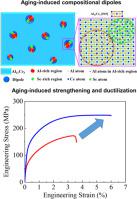当前位置:
X-MOL 学术
›
Acta Mater.
›
论文详情
Our official English website, www.x-mol.net, welcomes your feedback! (Note: you will need to create a separate account there.)
Atomic-scale compositional complexity ductilizes eutectic phase towards creep-resistant Al-Ce alloys with improved fracture toughness
Acta Materialia ( IF 8.3 ) Pub Date : 2024-06-24 , DOI: 10.1016/j.actamat.2024.120133 Meng Yi , Peng Zhang , Sihao Deng , Hang Xue , Chong Yang , Fuzhu Liu , Bin Chen , Shenghua Wu , Huaile Lu , Zhijian Tan , Jinyu Zhang , Yong Peng , Gang Liu , Lunhua He , Jun Sun
Acta Materialia ( IF 8.3 ) Pub Date : 2024-06-24 , DOI: 10.1016/j.actamat.2024.120133 Meng Yi , Peng Zhang , Sihao Deng , Hang Xue , Chong Yang , Fuzhu Liu , Bin Chen , Shenghua Wu , Huaile Lu , Zhijian Tan , Jinyu Zhang , Yong Peng , Gang Liu , Lunhua He , Jun Sun

|
Hierarchical microstructures spanning from micro-sized eutectic structure to nano-sized precipitates are promisingly engineered in lightweight Al alloys to improve the high-temperature creep resistance that is increasingly required for rapid industrial development. However, the intrinsically-brittle eutectic phase is ready to fracture upon applied loading, which, dramatically reducing room-temperature ductility and fracture toughness, greatly hampers practical applications of the creep-resistant Al alloys. Here, through the combination of Sc microalloying with sub-rapid solidification, we observe the ductilization of AlCe eutectic phase in cast heat-resistant Al-Ce-Sc alloys due to the formation of atomic-scale compositional complexity. High-concentration Sc atoms are frozen within the AlCe intermetallic phase by the sub-rapid solidification, which then assemble into unusual atomic-scale compositional dipoles with the Sc atoms enriched at one pole and the Al atoms at the opposite during subsequent heat treatment. The dispersed Sc-Al compositional dipoles induce local lattice distortions that stimulate dislocation activities, as temporally and spatially visualized by neutron diffraction tensile test and microstructural characterizations. The unexpected plastic deformation triggered in AlCe improves the deformation compatibility between the eutectic phases, enabling the sub-rapidly-solidified Al-Ce-Sc alloy to reach a room-temperature tensile elongation 3 times and fracture toughness over 8 times of its counterpart derived from traditional solidification. In addition, the sub-rapidly-solidified Al-Ce-Sc alloy exhibits an excellent creep resistance at 300 °C, achieving a tensile creep stress threshold of ∼ 70 MPa. These findings provide new perspectives on the design of ductile intermetallic phases and the development of creep-resistant Al alloys with application-level ductility.
中文翻译:

原子尺度的成分复杂性使共晶相延展成具有更高断裂韧性的抗蠕变 Al-Ce 合金
从微米级共晶结构到纳米级析出物的分级微观结构有望在轻质铝合金中设计,以提高工业快速发展日益需要的高温抗蠕变性。然而,本质上脆的共晶相在施加载荷时容易断裂,这大大降低了室温延展性和断裂韧性,极大地阻碍了抗蠕变铝合金的实际应用。在这里,通过 Sc 微合金化与亚快速凝固的结合,我们观察到铸造耐热 Al-Ce-Sc 合金中 AlCe 共晶相由于原子级成分复杂性的形成而发生延展。高浓度Sc原子通过亚快速凝固被冻结在AlCe金属间相中,然后在随后的热处理过程中组装成不寻常的原子级组成偶极子,其中Sc原子富集在一个极上,Al原子富集在相反的极上。分散的 Sc-Al 偶极子会引起局部晶格畸变,从而刺激位错活动,如中子衍射拉伸测试和微观结构表征在时间和空间上可视化的那样。 AlCe 引发的意外塑性变形改善了共晶相之间的变形相容性,使亚快速凝固 Al-Ce-Sc 合金的室温拉伸伸长率是其对应材料的 3 倍,断裂韧性是其对应材料的 8 倍以上传统凝固。此外,亚快速凝固Al-Ce-Sc合金在300°C下表现出优异的抗蠕变性,达到约70 MPa的拉伸蠕变应力阈值。 这些发现为延性金属间相的设计和具有应用级延展性的抗蠕变铝合金的开发提供了新的视角。
更新日期:2024-06-24
中文翻译:

原子尺度的成分复杂性使共晶相延展成具有更高断裂韧性的抗蠕变 Al-Ce 合金
从微米级共晶结构到纳米级析出物的分级微观结构有望在轻质铝合金中设计,以提高工业快速发展日益需要的高温抗蠕变性。然而,本质上脆的共晶相在施加载荷时容易断裂,这大大降低了室温延展性和断裂韧性,极大地阻碍了抗蠕变铝合金的实际应用。在这里,通过 Sc 微合金化与亚快速凝固的结合,我们观察到铸造耐热 Al-Ce-Sc 合金中 AlCe 共晶相由于原子级成分复杂性的形成而发生延展。高浓度Sc原子通过亚快速凝固被冻结在AlCe金属间相中,然后在随后的热处理过程中组装成不寻常的原子级组成偶极子,其中Sc原子富集在一个极上,Al原子富集在相反的极上。分散的 Sc-Al 偶极子会引起局部晶格畸变,从而刺激位错活动,如中子衍射拉伸测试和微观结构表征在时间和空间上可视化的那样。 AlCe 引发的意外塑性变形改善了共晶相之间的变形相容性,使亚快速凝固 Al-Ce-Sc 合金的室温拉伸伸长率是其对应材料的 3 倍,断裂韧性是其对应材料的 8 倍以上传统凝固。此外,亚快速凝固Al-Ce-Sc合金在300°C下表现出优异的抗蠕变性,达到约70 MPa的拉伸蠕变应力阈值。 这些发现为延性金属间相的设计和具有应用级延展性的抗蠕变铝合金的开发提供了新的视角。











































 京公网安备 11010802027423号
京公网安备 11010802027423号